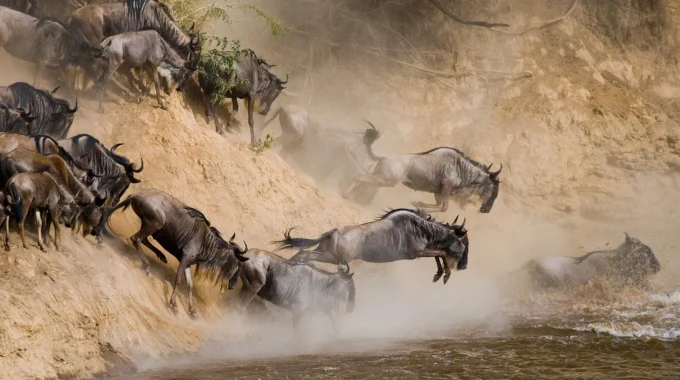A Kenya safari cost can vary significantly based on several factors, such as the season,…
Is Masai Mara in the Serengeti?
Is Masai Mara in the Serengeti? – No, the Masai Mara is not in the Serengeti, although the two are part of the same broader ecosystem and are often associated with each other due to their proximity and the famous annual Great Migration that occurs between them. Here’s a more detailed breakdown of the differences and the connection between these two incredible regions:

1. Location:
- Masai Mara: The Masai Mara National Reserve is located in southwest Kenya, near the border with Tanzania. It is in the Great Rift Valley and spans an area of about 1,510 square kilometers (583 square miles).
- Serengeti: The Serengeti National Park is located in northern Tanzania and covers a much larger area—about 14,750 square kilometers (5,700 square miles). The Serengeti ecosystem, however, extends beyond the national park and includes surrounding areas.
2. The Great Migration:
- Both the Masai Mara and the Serengeti are famous for their role in the Great Migration of millions of wildebeest, zebras, gazelles, and other herbivores. Every year, from July to October, these animals migrate from the Serengeti in Tanzania to the Masai Mara in Kenya in search of fresh grazing.
- The Mara River, which forms part of the border between the two regions, is a critical point in the migration. The animals must cross this river to reach the Masai Mara, often facing dangers from crocodiles and other predators.
- While the Serengeti is the primary calving and grazing area for much of the year, the Masai Mara becomes a key destination during the migration’s peak, especially in the dry season when water is scarcer.
3. Ecological and geographical differences:
- The Serengeti is characterized by vast, open savannahs, rocky outcrops called kopjes, and a more varied topography with higher grasslands, woodlands, and some forested areas. The Serengeti also features many rivers like the Grumeti and Mara that provide vital water sources for wildlife.
- The Masai Mara is typically more hilly and features slightly different vegetation, with more dense bush and forests compared to the Serengeti. It’s often seen as more “intimate” for safari-goers due to its relatively smaller size and the higher likelihood of seeing animals at close range.
4. Wildlife and Biodiversity:
- Both regions host a wealth of wildlife, including the Big Five (lion, leopard, elephant, buffalo, and rhinoceros), as well as cheetahs, giraffes, zebras, and a variety of antelope species. However, the Serengeti is known for its higher predator populations, including large prides of lions and cheetahs, while the Masai Mara is famous for its higher concentration of leopard sightings.
- The Masai Mara is also home to several unique Maasai communities, and you may encounter their traditional villages (called enkangs) as part of the cultural experience.
5. Management and Political Borders:
- The Masai Mara is a national reserve under the jurisdiction of the Kenyan government, while the Serengeti is a national park in Tanzania, managed by the Tanzanian government.
- The Maasai Mara region is named after the Maasai people, who are indigenous to this part of Kenya, while the Serengeti’s name comes from the Maasai word “Serengit,” meaning “endless plains.”
6. Cultural Connection:
- The Maasai Mara is culturally tied to the Maasai people, semi-nomadic herders who have lived in the area for centuries. Their presence and traditions are a significant part of the landscape and tourism experience in the Masai Mara.
- The Serengeti is a part of a larger cultural and historical landscape that various Tanzanian communities share, despite not being as closely associated with a single indigenous group as the Mara.
7. Tourism and accessibility:
- The Masai Mara is generally considered more accessible for international tourists, particularly because it’s close to Kenya’s major airports, such as Nairobi and Kisumu, and also boasts a wide range of accommodation options, from luxury lodges to tented camps.
- The Serengeti, while still a popular destination, is larger and has a more remote feel. It is more challenging to navigate by road, and many visitors arrive by small plane to one of its airstrips. However, the Serengeti is often considered a more classic safari experience due to its vast open plains and the sense of isolation it offers.
8. Climate:
- Masai Mara has a more temperate climate with cooler temperatures, especially in the evenings, due to its higher altitude.
- The Serengeti has a more arid climate, with warm temperatures year-round. Rainfall in the Serengeti is less predictable, and some parts can be quite dry during certain seasons.
Summary:
- Masai Mara is a national reserve in Kenya, whereas the Serengeti is a national park in Tanzania.
- The two regions are part of the same ecosystem and are connected through the annual Great Migration, but they are distinct in terms of geography, wildlife density, and cultural significance.
- Despite being close to one another and having many of the same animals, they are each managed by a different country and have distinctive qualities that make them each exceptional safari destinations.
So, is Masai Mara in the Serengeti? In short, the Masai Mara is not in the Serengeti, though they are intimately linked in the natural world, especially during the Great Migration.



